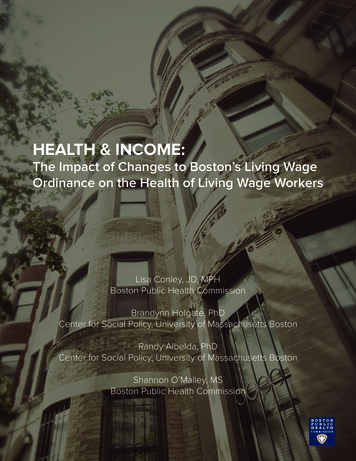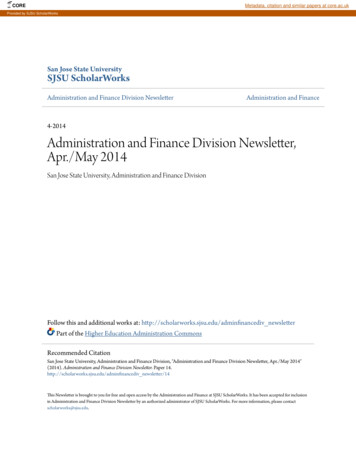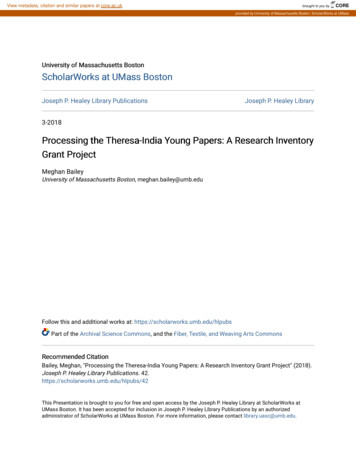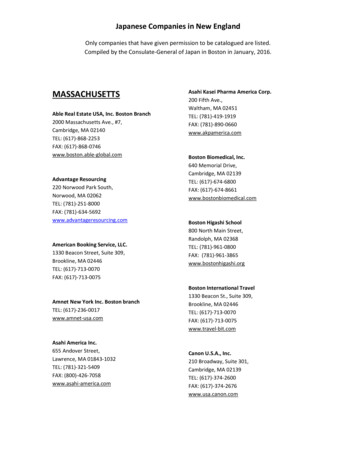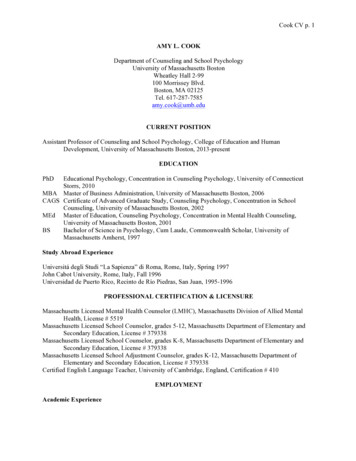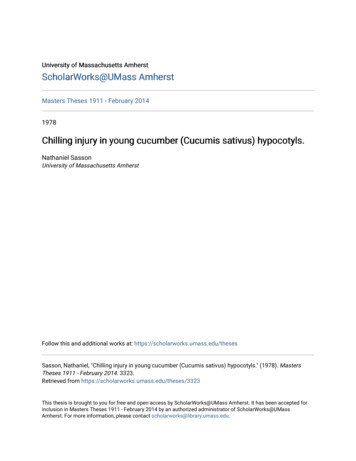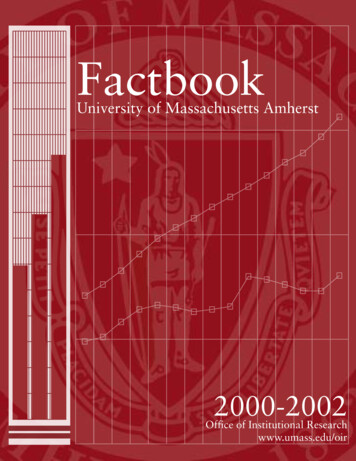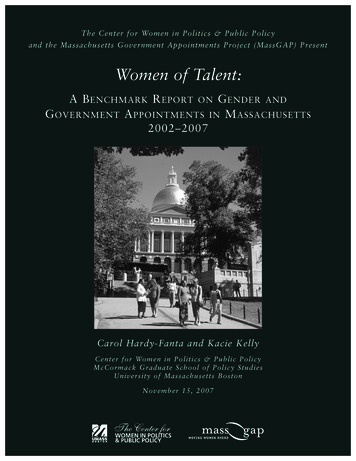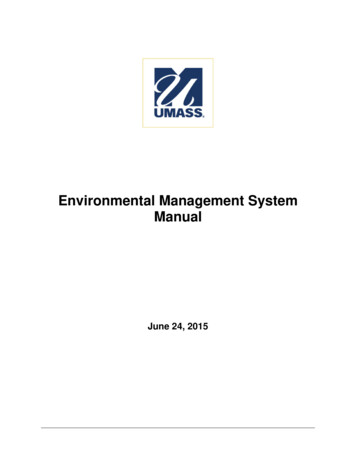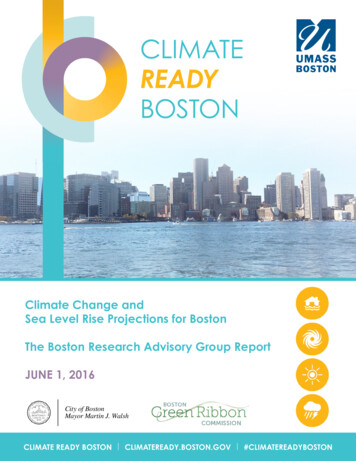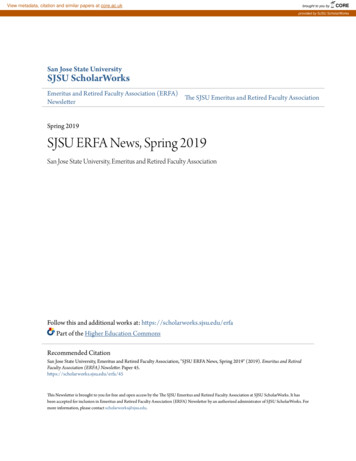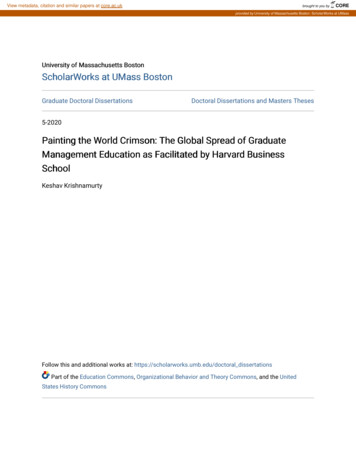
Transcription
View metadata, citation and similar papers at core.ac.ukbrought to you byCOREprovided by University of Massachusetts Boston: ScholarWorks at UMassUniversity of Massachusetts BostonScholarWorks at UMass BostonGraduate Doctoral DissertationsDoctoral Dissertations and Masters Theses5-2020Painting the World Crimson: The Global Spread of GraduateManagement Education as Facilitated by Harvard BusinessSchoolKeshav KrishnamurtyFollow this and additional works at: https://scholarworks.umb.edu/doctoral dissertationsPart of the Education Commons, Organizational Behavior and Theory Commons, and the UnitedStates History Commons
PAINTING THE WORLD CRIMSON: THE GLOBAL SPREAD OF GRADUATEMANAGEMENT EDUCATION AS FACILITATED BY HARVARD BUSINESSSCHOOLA Dissertation PresentedbyKESHAV KRISHNAMURTYPresented to the Office of Graduate Studies,University of Massachusetts Boston,in partial fulfillment of the requirements of the degree ofDOCTOR OF PHILOSOPHYMay 2020Business Administration Program
2020 by Keshav KrishnamurtyAll rights reserved
PAINTING THE WORLD CRIMSON: THE GLOBAL SPREAD OF GRADUATEMANAGEMENT EDUCATION AS FACILITATED BY HARVARD BUSINESSSCHOOLA Dissertation PresentedbyKESHAV KRISHNAMURTYApproved as to style and content by:Maureen A. Scully, Sherry H. Penney Chair in LeadershipChairperson of CommitteeEdward J. Carberry, Associate ProfessorMemberGabrielle Durepos, Associate ProfessorMount Saint Vincent UniversityMemberDavid L. Levy, Program DirectorOrganizations and Social Change TrackAlessia Contu, ChairDepartment of Management
ABSTRACTPAINTING THE WORLD CRIMSON: THE GLOBAL SPREAD OF GRADUATEMANAGEMENT EDUCATION AS FACILITATED BY HARVARD BUSINESSSCHOOLMay 2020Keshav Krishnamurty, B.A., St. Joseph’s College, BangalorePGDM, Indian Institute of Management LucknowPh.D., University of Massachusetts BostonDirected by Maureen Scully, Sherry H. Penney Chair in LeadershipThe growth and spread of business education worldwide is a phenomenon ofcontemporary interest, because it has enabled the expansion of a global managerial class thatoperates as social and economic elites worldwide in a time of growing inequality. I take ahistoric approach to this contemporary phenomenon by examining the role that HarvardBusiness School (HBS) played in the 1950s and 1960s in the conceptualization and launch ofthe now very prominent Indian Institute of Management (IIM) in Ahmedabad. Using thearchival materials at the Special Collections of the Baker Library at Harvard BusinessSchool, my research uncovers which players were involved, how they communicated, theirconcerns, the context in which they were operating, and how they constructed themselves asiv
influential and advanced institutional interests. In my first paper, I examine whether and howmeritocracy is invoked or implied as a legitimating aim for elite business education. I useactor-network theory, which I show is well suited for tracing the flows of people and ideas, totrack meritocracy, arguing that it is a “non-corporeal actant” that itself moves and changesacross international players, settings, and moments. In my second paper, I bring a criticalperspective to archives and how they are populated, considering the self-legitimation projectas HBS steps into a global role in the spread of graduate management education. I examinethe signaling moves in the saved correspondence, in terms of personal connections, decisionpoints, explicitly stated interests, status markers or judgments of others, and reference tocompetitor institutions. I find that the web of connections among elites is intertwined withCold War political considerations of HBS administrators. My third paper is an ethnographiccase study of the physical spaces, rituals, and processes of the archive at Baker Library andhow these serve to legitimate HBS to itself, while using the experience of visiting thearchives at MIT containing records of the role of the MIT Sloan School in the formation ofthe IIM in Calcutta as a comparison. Overall, my dissertation explores an important historicmoment when HBS helped set the stage for a global managerial elite.v
ACKNOWLEDGEMENTSMy thanks go, in no particular order, to the people who have been so important to meduring my time as a PhD student. Special thanks go to my advisor, Dr. Maureen Scully, whohas been a mentor and a friend throughout my time as a PhD student, one of the mostbrilliant people I have ever known, and one with a deep sense of humility, compassion, andwhat it means to give back to society. I’m proud to have been your student. I don’t think I’veever known anyone quite like you before, and I doubt I’ll ever meet anyone quite like you infuture.I would also like to thank Dr. Edward J. Carberry, both for giving me my introductionto the kind of research that academia involves from way back in 2014, and for showing mehow to handle any class like a master. Dr. Gabrielle Durepos introduced me to ActorNetwork Theory and through it a whole lot more about Critical Management Studies, and insome ways I literally wouldn’t be the person I am without her. Ed and Gabie, thank you forthese, and for so many other things big and small. I also thank Dr. Pacey Foster and Dr.Stephan Manning for discussions, advice and help on many things, both academic andotherwise.Special thanks to my buddies in the PhD program, in particular the wonderful andever-amazing Chris Whynacht, who gave me a whole lot of fun in the good times and was anvi
enormous support throughout the bad. Chris old buddy, I doubt I’ll ever be able to thank youenough for everything you’ve done for me. I can scarcely go without mentioning the amazingDr. Georgianna Melendez, who is one of the strongest, sweetest and kindest people I know (Ihad to sum it up for you and Chris or I’d be going on about you forever). Many thanks toTom Bejarano (you’re capable of far more than you know, old buddy!), Paul Case, DebraButler, Chacko Kannothra, Dr. Erynn Beaton, and Dr. Nicole Wissman-Weber for all thegreat times we had together; you’re all the smartest, funniest, nicest, most wonderful peopleI’ve known.I would also like to thank my gracious hosts at Saint Mary’s University in Halifax,Nova Scotia, Dr. Albert J. Mills and Dr. Jean Helms Mills, both of whom were ofimmeasurable help in my Canadian experience, helped me further my knowledge andexperience of Actor-Network Theory and introduced me to the International DoctoralConsortium right beside the extraordinary Dr. Stefanie Ruel. Albert and Jean – andStephanie! - the IDC has always been a great experience in every year I’ve been in it, and Ihope you found me of help in trying times. Thanks also to Nick Deal, Rene Arsenault,Caterina Bettin, Hanh, David Iremadze and the many other new friends I met in Halifax forbeing around during a whole different phase of existence for me.And finally, I wish to thank all the reference desk staff at the Baker Library,particularly Melissa Murphy, Christine Riggle, Liam Sullivan, Keith Pendergrass, TimMahoney, director Laura Linard, former research staff member Katherine Fox who helpedme in my very first days, as well as everyone else whom I’ve met and known by face but notvii
by name. Your friendliness, professionalism, and willingness to go that extra mile in order tohelp me in my research deeply impressed me – frankly, I think Harvard should be proud ofhaving such amazingly dedicated folks take care of the Special Collections! Thank you all formaking my many research trips to the Baker Library as fascinating, informative andproductive as they could possibly be.viii
TABLE OF CONTENTSACKNOWLEDGEMENTS.viCHAPTERPage1. INTRODUCTION .12. COMPARING INSTITUTIONAL THEORY AND ACTOR-NETWORK THEORYTHROUGH THE HISTORICAL DEVELOPMENT OF MERITOCRACY .8Introduction.8Meritocracy and the Business School.10Institutional Theory.11Structure versus Agency.12Translation of Institutions.14Actor-Network Theory and after.15Institutionalization.17Translating . HARVARD BUSINESS SCHOOL ENTERS THE TWILIGHT STRUGGLE IN INDIA.35Introduction.35Background.38Indian Institutes of Management.43Foundations and Americanization.45Research Design.48Method.51Findings.56List of Key Players.56Collections containing IIM Materials .59Materials within the Archives and People to whom they pertain .66First Letter: Sarabhai approaches HBS .68HBS’s relationship with India .74Ford Foundation pressure and decision-making .78Correspondence from Sarabhai’s May 3rd visit and afterwards .90Memo to Acting Dean George P. Baker on April 13, 1962 .103General themes prevalent in the documents .116Discussion .119ix
CHAPTERPagePart 1: Placing Harvard within India .119Part 2: John Kenneth Galbraith’s silence, and Harvard Business School’srole in Cold War foreign policy .132Conclusion.142References.1464. ARCHIVES AS SITES OF SELF-LEGITIMATION .156Introduction .156Literature Review: What is an archive? . 160Method and Findings .165Context: The physical space of the archive at HBS .166Comparison: Archive at MIT .176Discussion: Archives as influences upon their users throughout history .179Future Research: Evocations, the antithesis of silences in an archive .183References. . 1895. CONCLUSION.194APPENDIX: TRANSCRIPTS OF THE ORIGINAL DOCUMENTS FROM THE SPECIALCOLLECTIONS.200Letter from Vikram Sarabhai to John B. Fox dated April 1, 1961 .200Letter from A. R. Towl to John B. Fox dated April 5, 1961 .202Memorandum from John B. Fox to R.H. Hassler dated April 10, 1961 .204Memorandum from Harry L. Hansen to Stanley F. Teele dated April 11, 1961 .208Memorandum from R. H. Hassler to Stanley F. Teele dated April 13, 1961 .211Response by Stanley F. Teele to April 11 memo by Hansen, April 18, 1961 .213Letter from George F. F. Lombard to John B. Fox dated April 18, 1961 .214Letter from Harry L. Hansen to Stanley F. Teele dated April 18, 1961 .216Letter from John B. Fox to Prof. M. S. Thacker dated May 4, 1961 .218Memorandum from John B. Fox to Stanley F. Teele dated May 4, 1961 .219Chronological summary of discussions and correspondence dated May 15, 1961 .224Letter from John B. Fox to Harry L. Hansen dated June 5, 1961 .229Letter from John B. Fox to Harry L. Hansen dated July 13, 1961.234Memorandum from John B. Fox to Stanley F. Teele dated July 18, 1961 .235Letter from George W. Robbins to R. H. Hassler dated April 25, 1961.238Letter from Harry L. Hansen to Kamla Chowdhry dated December 26, 1962 .240Letter from Henry B. Arthur to George Lombard dated March 9, 1964 .242Letter from Howard Baumgartel to Charles D. Orth dated December 20, 1963 .245x
APPENDIXPageLetter from Harry L. Hansen to Mercer Brugler, dated March 17, 1964 .247Letter from U.S. A.I.D. to Harry L. Hansen, dated 3 March 1964 .249Letter from R. Bruce Cuthbertson to Harry L. Hansen dated December 20, 1963 .251Letter from Ralph W. Hidy to Harry L. Hansen dated April 22, 1964 .256Letter from Harry L. Hansen to Ralph W. Hidy dated April 29, 1964 .257Letter from Maurice Zinkin to Harry L. Hansen dated 7th February 1964 .258Partial transcript of memorandum to George P. Baker dated April 13, 1962 .259xi
CHAPTER 1INTRODUCTIONThe growth and spread of business education worldwide is a phenomenon ofcontemporary interest. Management education is now increasingly based on modelsdeveloped within the United States, and spread by a growing number of business schoolsacross the world. These institutions attract students who wish to belong to a globalmanagerial class, a class whose more highly placed members operate as social and economicelites worldwide. The growth of business education, like that of elite higher education ingeneral, has served to legitimize and reproduce existing social and economicarrangements(Subramanian, 2015; Warikoo, 2018; White et al., 2017) and has led to growinginequality as those who have opportunities to join the higher echelons of the globalmanagerial class gain access to social and material rewards and benefits that growincreasingly scarce for those who do not.Although the growth of management education is widely perceived by the generalpublic as being “in the ether”, as though it were almost fated or inevitable, or in some sense anatural phenomenon, I choose to follow the lead of scholarship that has investigated the1
planned and deliberate diffusion of management education globally. Scholarship on thediffusion of business practices and ideas, both within business education and among globalbusiness enterprises is relatively plentiful; it is also more often focused on ongoing or recentdevelopments in the field than on historical events or developments that led to presentconditions.I choose to take a historic approach to this contemporary phenomenon because I seekto investigate its early beginnings, which are relatively little studied and potentially offergreater room for understanding how and why management education has attained its currentstate of prominence. I seek to uncover new information and reassemble existing informationin order to further our present understanding of how global management educationdeveloped; to better understand the current system of education that promotes the role ofbusiness executives as a socioeconomic elite as the deliberate product of human action andone possible system of global education rather than as the only possible system of educationbrought about by an inevitable free-market, neoliberal “end of history”.Scholarship has already revealed how, beginning largely within the United States andspreading internationally, various players developed elite business education and promoted itin order to spread the meanings and norms surrounding the role of business executives as asocioeconomic elite(Khurana, 2007; Khurana & Penrice, 2011). Scholars have largelyfocused on the role of the founders of elite business institutions, for example the case of theWharton School(Sass, 1982), or in the role of philanthropic foundations such as the FordFoundation in the spread of management education both within America and2
internationally(Berman, 1983; Khurana, Kimura, & Fourcade, 2011; Parmar, 2011). I seek toadd greater understanding by exploring an additional dimension – the potential role ofbusiness schools in directly influencing the growth of management education worldwide.I choose to examine the role that Harvard Business School (HBS) played in the 1950sand 1960s in the conceptualization and launch of the now very prominent Indian Institute ofManagement (IIM) at Ahmedabad. HBS, founded in 1908, has been highly influential in thefield of global business education and has brought significant change to the development ofbusiness education both on its own as well as in association with foundations like theaforementioned Ford Foundation and business consultants such as McKinsey(Khurana, 2007;McDonald, 2017). IIM Ahmedabad, founded in 1961, is among the highest rated of the IIMs,which in turn constitute many of the most highly rated business schools in India – graduatesof IIM Ahmedabad have significant social and economic opportunities within India andcompete globally with graduates of top business schools from around the world for the samehigh corporate positions(Annabhai, 2011).Understanding if and how HBS influenced the growth and the standing of IIMAhmedabad would add to our understanding of how the seeds for the growth of the currentglobal managerial elite were spread; through a deep dive into archival material at the SpecialCollections of the Baker Library at HBS, I seek to add a more nuanced understanding ofthese developments by attempting to disentangle the role and contributions of HBS properfrom that of the Ford Foundation, which was also involved with IIM Ahmedabad. I explorethe possibilities that HBS had its own interests and desires and that HBS’s administrators3
may have acted to further its standing, legitimacy and global influence through the growth ofinternational business education.My dissertation is comprised of three interconnected papers exploring the role ofHarvard Business School in the global spread of graduate management education. In my firstpaper, I examine whether and how meritocracy is invoked or implied as a legitimating aimfor elite business education. Meritocracy is a social system in which merit or talent is thebasis for sorting people into positions and distributing rewards such that people in positionsof greatest authority are occupied by those having the most merit(Scully, 1997). It has beenused to legitimize elite status as well as reproduce inequitable social arrangements(McCoy &Major, 2007; Mijs, 2009; Scully, 2002). In recent years, meritocracy has become a topic ofincreasing interest, with papers examining its effects on a broad variety of subjects such asperceived income inequality(Mijs, 2018; Roex, Huijts, & Sieben, 2019), social classachievement within education(Darnon, Wiederkehr, Dompnier, & Martinot, 2018; White etal., 2017), and gender and racial inequality(Soares, 2017; Warikoo, 2017, 2018).In order to track meritocracy, I use Actor-Network Theory(Callon, 1986; Latour,1986; Law, 1992), described as a body of theoretical and empirical writing that treats socialrelations, such as power and organization, as the outcome of interactions of actors in anetwork(Hartt, 2018). An actor is defined as an entity, even one without physical existence,that makes a perceptible influence by making others be(Law & Mol, 2008) Under thisapproach, society itself is studied as a collection of human and non-human, even non-livingand abstract actors in a complex network of changing relationships, which are unraveled4
and/or traced through networks of connection(Wheeler, 2010). I show that this approach iswell suited for tracing the flows of people and ideas, arguing that meritocracy emerges fromthese interactions as a “non-corporeal actant”(Hartt, 2013; Hartt, Mills, Helms Mills, &Corrigan, 2014) that itself moves and changes across international players, settings, andmoments.By demonstrating that the idea of meritocracy, which has been institutionalized as aprocess in business education on one hand but has been understood and enacted differentlyby different actors at different points in time – from, for instance, Jefferson enacting itthrough his writings and speeches in the form of “natural aristocracy” across America’spolitical scene to justify inequality to 18th century Harvard students justifying their relativesocial standing based on their examination grades, to its varied 20th century applications – Ishow that the idea of meritocracy is itself subjective and dependent on interpretation bygroups or even individuals and changing its nature depending on the relationship between the‘judges’ and the ‘judged’. I use this case to suggest that it might be more efficacious forscholars interested in institutional theory to consider the use of actor-network theory andmore specifically the construct of the non-corporeal actant. To do so would probably shedgreater light on the subjective aspect of how ideas and processes become institutionalizedthrough the interactions between the unique individuals holding them, more so than if theytreated them as the more objectively framed “institutions”.In my second paper, I bring a critical perspective to archives and the materials thatthey store, considering the idea of self-legitimation. I examine the idea that HBS engaged in5
a project of self-legitimation as it stepped into a global role in the spread of graduatemanagement education during the early Cold War era. I undertake a deep study of thearchival materials belonging to the Indian Institute of Management, Ahmedabad Records atthe Special Collections of the Baker Library at Harvard Business School. I surfacecorrespondence among influential individuals at HBS and the IIM in Ahmedabad, whichreveal how they construct themselves as influential as well as how they advance Harvard’sinterests as they interpret them. My research discovers the timeline of events, which playerswere involved, how they communicated, what kinds of concerns they had, and the context inwhich they took their decisions. In doing so, I aim at advancing a new point of view thatcontains information not previously revealed in the official record.I emphasize the various signaling moves in the letters, memoranda and otherdocuments that are saved so carefully and methodically in the archives (itself an interestingmove that indicates a sense of self-legitimacy and importance) to uncover the history ofevents that took place. I reveal overarching themes in terms of personal connections, decisionpoints, explicitly stated interests, status markers or personal judgments of others, andreferences to competitor institutions. In addition to uncovering greater detail than is availablein the official record, I find that the web of connections among elites is intertwined with ColdWar political considerations of HBS administrators and is tied in with a strain of Americandiscourse surrounding the importance of India to the United States and its allies during thelate Eisenhower and Kennedy administrations. In subtexts and asides, these administratorstalk about how graduate management education could reinforce free-market capitalism,6
industrial development and democracy in a nation whose role was perceived to be crucial in aworld that appeared to be under threat of encroachment from dictatorial communism.Wherever possible, I have included partial or complete transcriptions of thedocuments cited in my second paper in the appendices.My third paper is a study of the material projection of legitimation through the natureand symbols of the archives and archival spaces at the Baker Library. After reviewingliterature on archives that reveals their symbolic and legitimating functions across history, Iconduct a brief ethnographic case study of the physical spaces, rituals, and processes of thearchive and how these serve to legitimate HBS to itself, while using the ethnographicexperience of visiting the archives at the Massachusetts Institute of Technology as acomparison.Overall, my dissertation explores an important historic event and its associated periodin the global spread of graduate management education, when it was heavily guided andinfluenced by HBS. This event took place even as HBS actors made sense of their own rolein global management education, elected to save their personal documents in a carefullycurated archive, and set the stage for a future global managerial elite in India and beyond.7
CHAPTER 2COMPARING INSTITUTIONAL THEORY AND ACTOR-NETWORK THEORYTHROUGH THE HISTORICAL DEVELOPMENT OF MERITOCRACYIntroductionModern institutional theory, which was developed beginning in the late 1970s,following the works of Meyer and Rowan(1977) and Zucker(1977), has since become one ofthe dominant theories within Organization Studies(E. R. Greenwood, Oliver, Suddaby, &Sahlin, 2013). However, drawing on Suddaby(2010), institutional theory has been stretchedbeyond its original meaning of studying how organizational structures and processes acquiremeaning and continuity beyond their technical goals. Institutions themselves are treated asreified constructs or black boxes; and there is considerable potential for research that tries toexamine the potential for institutionalization directly.Scholars engaged in critical research have historically been unfamiliar withinstitutional theory and therefore less likely to critique it(Cooper, Ezzamel, & Willmott,2008). At present, Actor-Network Theory (hereafter ANT) is growing increasingly popularamong critical scholars in multiple fields of study, including management and organizational8
theory. Although institutional theorists have incorporated elements of ANT into institutionaltheory to study the process of institutionalization, particularly in the subfield of Scandinavianinstitutionalism(Boxenbaum & Pedersen, 2009; Scheuer, 2008)(Boxenbaum & Pedersen,2009; Scheuer, 2008) to address perceived shortcomings, none have directly questioned theneed for institutions as a theoretical construct.(Boxenbaum & Pedersen, 2009; Scheuer,2008) If institutions are fictions actively created and re-created by actants in an actornetwork, as Lawrence and Suddaby(2006) remind us, it may now be relevant and timely toask whether institutions are a necessary fiction for researchers to use in all cases ofinstitutionalization.Towards this, I argue in this chapter that ANT and the concept of a Non-CorporealActant (hereafter NCA) provide a plausible alternative for understanding the processes ofinstitutionalization and translation, particularly in complex conditions with a wide set offactors. An ANT approach may open the “black box” that addresses unanswered questionssurrounding structure and agency in institutional theory.I provide a brief overview of both institutional theory and ANT and use the exampleof meritocracy, its development within American business education and spread to Indianbusiness education to compare both theories.9
Meritocracy and the Business SchoolMeritocracy is a social system in which merit or talent is the basis for sorting peopleinto positions and distributing rewards such that people in positions of greatest authority areoccupied by those having the most merit(Scully, 1997). It has been used to legitimize elitestatus as well as reproduce inequitable social arrangements(McCoy & Major, 2007; Mijs,2009; Scully, 2002). In recent years, meritocracy has become a topic of increasing interest,with papers examining its effects on perceived income inequality(Mijs, 2018; Roex et al.,2019), social class achievement within education(Darnon et al., 2018; White et al., 2017),and gender and racial inequality(Soares, 2017; Warikoo, 2017, 2018). It is associated withthe growth of different forms of quantitative evaluation, a general increase in the number ofte
PAINTING THE WORLD CRIMSON: THE GLOBAL SPREAD OF GRADUATE MANAGEMENT EDUCATION AS FACILITATED BY HARVARD BUSINESS SCHOOL May 2020 Keshav Krishnamurty, B.A., St. Joseph's College, Bangalore PGDM, Indian Institute of Management Lucknow Ph.D., University of Massachusetts Boston Directed by Maureen Scully, Sherry H. Penney Chair in Leadership
